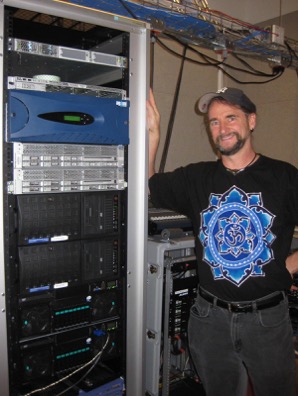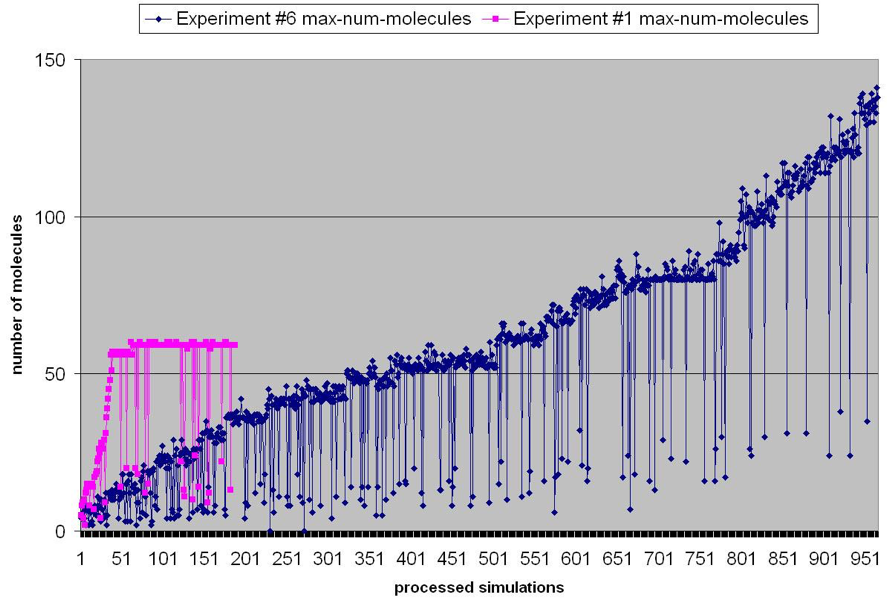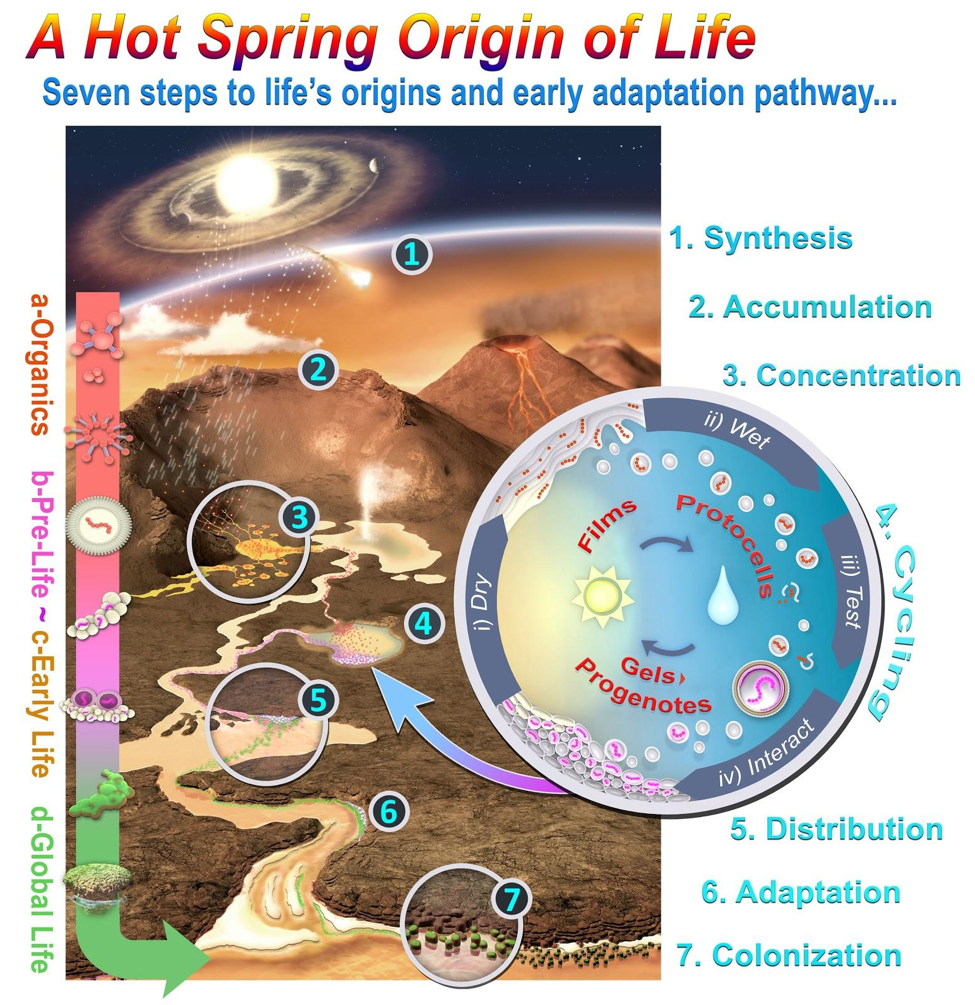Discovering the Origins of Life, One Simulation at a Time
By Tiffany Fox

San Diego, Calif., Qualcomm Institute 2018 — Somewhere on one of the crowded floors of UC San Diego’s Qualcomm Institute sits the server stack (figure 1) that provided a potential quantitative solution for one of the deepest and oldest mysteries in science: where and how life began.

It led to research so compelling that Scientific American will include it in an upcoming Special Issue called “Revolutions in Science,” after already featuring the research as the cover story of its August 2017 edition — “THE NEW ORIGINS OF LIFE: Did volcanic hot springs harbor the first living organisms?” (see figure 2).
Computations performed in the Qualcomm Institute’s Terascale Data Center suggest that the preeminent theory of life’s origins — that hydrothermal vents on the ocean floor provided the energy and nutrients needed for life to begin — is not the only option. Instead, researchers now believe that geysers, hot springs and steaming land pools that repeatedly dry out and get wet again better provide the key ingredients and cycling organizational processes required for the origin of life. (Read Scientific American’s article here).
This begs another question: Is NASA looking in the right places for extraterrestrial life?
A Herculean task (even by NASA standards)
The story begins — as so many in academia do — with a deadline. In late 2010, Bruce Damer, now a research associate with the UC Santa Cruz Department of Biomolecular Engineering, was struggling to complete his Ph.D. work at University College Dublin in Ireland. His Herculean task was to wrangle what he called a “seriously underpowered and tired” server array he’d inherited from his NASA mission work into running billions of additional tiny simulations. But these weren’t just any simulations. These were simulations of specially crafted virtual environments designed to determine which precise combination of variables would cause atoms to bond and go on to form longer and longer chains.
In other words, Damer was on a quest to find the mathematical algorithm that would explain how the universe built up more complex compounds from simpler atoms and then made the next logical leap to create life. His major problem was that his computers didn’t have enough horsepower, and time was running out.
 “I had conceived of this monumental project way back in 1985 when I first started work on my PhD at the University of Southern California, as it turned out… 25 years too soon as there was inadequate computing power, no tools, and no colleagues who understood what I was saying!” recalls Damer. “The objective as I re-started my PhD in 2008 was to run these small volume molecular dynamics simulations in a network I named the EvoGrid (for Evolution Grid), to simulate an atomistic soup like those found in deep space. We had to run simulations for months for each experiment.”
“I had conceived of this monumental project way back in 1985 when I first started work on my PhD at the University of Southern California, as it turned out… 25 years too soon as there was inadequate computing power, no tools, and no colleagues who understood what I was saying!” recalls Damer. “The objective as I re-started my PhD in 2008 was to run these small volume molecular dynamics simulations in a network I named the EvoGrid (for Evolution Grid), to simulate an atomistic soup like those found in deep space. We had to run simulations for months for each experiment.”
That’s when Damer reached out to John Graham, a senior development engineer at the Qualcomm Institute. Damer had met Graham 15 years before and recalls Graham as “the traveling tech genius who had helped invent one of the first video streaming services on the Internet and brought webcasting to Burning Man in the 90s by microwave, ISDN and satellite.”
Graham had since set up shop at the Qualcomm Institute, the UCSD division of the California Institute for Telecommunications and Information Technology (Calit2), where he was running a geodata pipeline in the institute’s Terascale Data Center, a group of servers donated by Intel that process hundreds of terabytes of MODIS satellite data and are still in use today.

Prior to Damer’s call, Graham had equipped the Terascale machines with an alpha version of Zen Cloud Platform Virtualization, which he explained “allows multiple users to use the same platform on guest virtual machines without getting each others way.” This way, instead of having to install operating system software on multiple computers, multiple computers can all run on the same underlying operating system via virtual hardware (also known as a “hypervisor”).
Graham describes the stack as a micro-supercomputer, i.e. “several nodes away from being a supercomputer, but with more local storage.” Although there were other such server stacks at the time, Damer and his chief engineer Peter Newman chose the one at Calit2 because academic server allocations only happen about every six months.
“Agility is an important part of science,” Graham said. “You have to be able to move quickly because funding evaporates, people leave or someone else has the same idea.”
For Graham there was another key incentive to use his server stack. Machines are expensive, but virtual machines are free.
“Any machine would have worked,” he noted. “It’s just a matter of having access to it, and having the attitude of ‘yes’ instead of ‘maybe’ or ‘no.’ For me, it goes back to the Burning Man concept of radical inclusion, which has been a substantial influence in my career. I like to say ‘yes’ all the time, especially when it comes to cool science.”

Damer says the server stack at Calit2 improved the speed of his simulations by eight-fold and, within four short months, enabled his team to complete the illuminating “Experiment No. 6” — the simulation that resulted in bonds forming between a whopping 179 atoms of the 1,000 atom inventories (see figure 3). This simulation substantiated a tell-tale “staircase to complexity” effect predicted by complexity theorist Stuart Kauffman (see figure 4).
“The EvoGrid provided an analytical and computational demonstration that rapid and irreversible hill-climbing can occur in small volumes of simulated chemistry subject to stochastic selection,” Damer said. “It showed that we were actually climbing a truly rugged landscape in these atomistic soups and that this was plausibly the same mechanism used by the evolution of the cosmos and also of life itself.”
With this breakthrough, Damer was able to submit and defend his Ph.D. in time and go on to devote many additional years of work on the origin of life in collaboration with chemistry professor David Deamer at UC Santa Cruz. This form of “combinatorial selection” implemented in the EvoGrid inspired his initial conversations with Deamer and led to their joint quest to identify a mechanism enabling life's origins. To illustrate how this hill-climbing algorithm applies to biology Damer gives a metaphor from Charles Darwin’s famous finches. While Darwin was exploring the Galapagos Islands in 1835, he observed how “finches adapted to local optimal conditions by evolving their beak shapes, to crack nuts here, or poke around for insects there, but the finches always gave birth to baby finches with slightly different beak shapes just in case the supply of nuts or insects changed and they had to start to switch roles. So finches, like atoms forming into molecules, climb successive hills of complexity, wobble off those hills a bit, and are therefore able to find connecting ridges to even taller hills (bigger molecules) nearby. The complexifying universe as well as the evolving living world could plausibly be characterized by these same interconnected landscapes,” Damer summarized in his PhD thesis.
The work ultimately culminated in two foundational articles in the journal Life, as well as the Scientific American cover story that announced the hypothesis to the world. The article was co-authored with Deamer, Martin Van Kranendonk and his student Tara Djokic, two geologists in Australia who discovered the oldest evidence for life on land in 3.5 billion year old rocks preserving evidence of a hot spring. In 2015 Damer and Deamer journeyed to the site of this discovery with Van Kranendonk and Djokic which solidified their ideas and collaboration.
When asked about his role in the project, Graham demurs.
“It was simple,” Graham said. “I set up the virtual machines that they needed, gave [Damer’s] team the logins and made sure to keep the machines running. They would run an experiment, and if it failed they would simply run another one.”

Scientific American Re-publication in 2018 as a Possible Revolution in Science
Scientific American is re-publishing the article on July 11, 2018 as part of a special issue called “Revolutions in Science.” The UCSC team led by Damer and Deamer has recently gone on to demonstrate the formation of vesicles (simple primitive non-living cells) in waters taken directly from the hot springs in Yellowstone National Park. Several universities are now constructing chambers which will create artificial hot springs and subject them to wet-dry cycling in conditions believed to be present on the early Earth over four billion years ago. The full “Hot Spring Hypothesis” for an origin of life was recently integrated by Damer into one view including the geology, hot springs, cycling pool, and the origin and early evolution of life (figure 5 reproduced in the Scientific American article).
A butterfly flaps its wing, and a Mars Rover is Redirected
Returning back to the search for evidence for life beyond the Earth. Damer and colleagues are now part of a team advising NASA on where to land their next rover on Mars to search for signs that the red planet might have harbored life. And they are trying to convince NASA to send the Mars2020 mission to examine the rocks at, you guessed it, an ancient hot spring! This is a truly Herculean task but armed with their new (and testable) end-to-end hypothesis for an origin of life, these researchers may just have a shot at it. But, insists Damer, that original 2017 magazine cover story, the hypothesis, and NASA’s new direction would not have existed if it had not been for Graham and Calit2.
“When the story of this major new hypothesis is written by historians of science,” Damer said, “Graham will feature centrally in its telling.”
“It is a butterfly effect for sure,” Graham says. “I was one wing of a butterfly.”
Media Contacts
Tiffany Fox
(858) 246-0353
tfox@ucsd.edu

